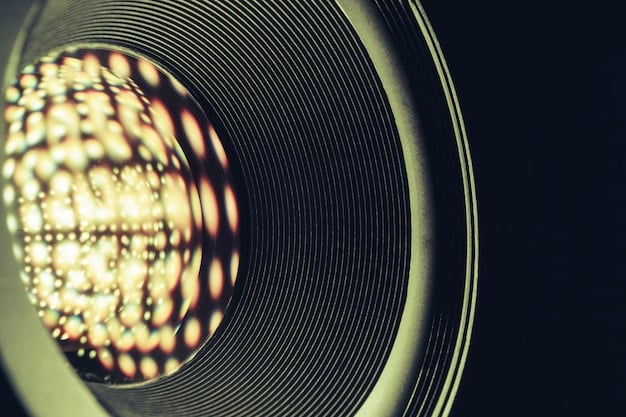ASCAP & BMI Royalty Changes: What Emerging Artists Need to Know

ASCAP and BMI royalty rate changes are crucial for emerging artists to understand to navigate the complexities of music publishing and ensure fair compensation.
Understanding ASCAP and BMI: Key Roles in Royalty Collection
As an emerging artist, understanding the roles of **ASCAP and BMI royalty rate changes** is essential for managing your music royalties. These organizations play a critical role in ensuring you get paid for your work.
ASCAP (American Society of Composers, Authors and Publishers) and BMI (Broadcast Music, Inc.) are two of the largest performing rights organizations (PROs) in the United States. They act as intermediaries between songwriters, composers, music publishers, and those who want to publicly perform their music. These PROs collect license fees from various entities, such as radio stations, television networks, venues, and digital streaming services, and then distribute those royalties to their members.
What Do ASCAP and BMI Really Do?
- Licensing: They issue licenses to businesses and organizations that want to play music in public.
- Royalty Collection: They collect royalties based on the use of their members’ music.
- Distribution: They distribute these royalties to songwriters, composers, and publishers.
The Significance of Royalty Rates for Emerging Artists
Royalty rates directly impact an emerging artist’s income. Understanding these rates and how changes can affect your earnings is crucial for financial planning and career sustainability.
Changes in royalty rates can significantly impact how much an emerging artist earns from their music. For instance, an increase in the royalty rate for digital streaming could mean a substantial boost in income for an artist whose music is heavily streamed. Conversely, a decrease could lead to financial strain. By staying informed and understanding how these changes affect their revenue streams, artists can better manage their finances and ensure they are fairly compensated for their work.
Why Royalty Rates Matter
* Direct Impact on Income: Royalty rates affect the earnings from streams and public performances.
* Negotiating Power: Understanding rates helps in negotiating better terms.
* Financial Planning: Knowledge of rates aids in accurate financial forecasting.

Key Changes in ASCAP and BMI Royalty Rates: An Overview
Several factors influence the royalty rates set by ASCAP and BMI, including legal battles, industry trends, and negotiations with licensees. Emerging artists need to keep an eye on these changes to anticipate potential shifts in their income.
ASCAP and BMI periodically revise their royalty rates to reflect changes in the music industry landscape. These revisions can stem from various factors, including legal battles with digital streaming services, shifts in industry trends (e.g., the rise of podcasts or online gaming), and negotiations with licensees like concert venues and radio stations. For example, if a court rules that digital streaming services must pay higher royalties, ASCAP and BMI are likely to renegotiate their agreements with those services, which can impact the rates paid to artists. Consequently, emerging artists should closely monitor any announcements or news related to these organizations to anticipate potential shifts in their royalty income.
Factors Influencing Royalty Rate Changes
* Legal Battles: Court decisions can alter the rates paid by streaming services.
* Industry Trends: New platforms and technologies impact royalty distribution.
* Negotiations: Agreements with licensees affect the overall royalty pool.
Navigating the Complexities: Tips for Emerging Artists
Navigating royalty rates can be challenging, but there are steps you can take to ensure you’re getting what you deserve. Joining a PRO like ASCAP or BMI is the first step, but understanding your rights and regularly reviewing your statements is equally important.
One practical step is to regularly review your royalty statements from ASCAP or BMI. Compare the usage data to your own records of performances and streams to ensure accuracy. If you spot discrepancies, don’t hesitate to contact the PRO to inquire about them and request a review. Additionally, consider educating yourself further by attending industry workshops or webinars focused on music publishing and royalties. Many organizations offer affordable educational resources that can help you better understand the intricacies of the royalty system and advocate for your rights.
Practical Steps to Take
* Join a PRO: Affiliate with ASCAP or BMI to collect royalties.
* Understand Your Rights: Know what you are entitled to receive.
* Review Statements: Regularly check your royalty earnings for accuracy.
Digital Streaming and Its Impact on Royalty Distribution
Digital streaming has revolutionized the music industry, becoming a primary source of revenue for many artists. However, it has also introduced complexities in royalty distribution.
Digital streaming has fundamentally reshaped how music is consumed and monetized. Platforms like Spotify, Apple Music, and Amazon Music now dominate the music market, generating a significant portion of revenue for both established and emerging artists. However, the intricacies of royalty distribution in the digital age can be challenging to navigate. Digital streaming services often have complex algorithms for calculating royalties, taking into account factors like the number of streams, the location of the listener, and the type of subscription. As a result, the royalties generated from digital streaming can be quite variable and sometimes unpredictable.
Understanding Digital Streaming Royalties
* Streaming’s Dominance: Streaming is now a primary revenue source.
* Complex Algorithms: Royalty calculations involve various factors.
* Variable Income: Streaming royalties can fluctuate significantly.

Future Trends in Royalty Collection and Distribution
Emerging artists must stay informed about future trends in royalty collection and distribution to adapt to the changing landscape and maximize their earnings.
Looking ahead, several trends are likely to shape the future of royalty collection and distribution for emerging artists. Blockchain technology, for example, has the potential to revolutionize the way royalties are tracked and paid, providing greater transparency and efficiency. Artificial intelligence (AI) could also play a role in analyzing music usage data and identifying potential royalty discrepancies. Additionally, there is a growing movement towards direct licensing, where artists negotiate directly with music platforms, bypassing traditional PROs and potentially increasing their earnings. By staying informed about these emerging trends and adapting their strategies accordingly, emerging artists can position themselves for success in the evolving music industry.
Emerging Trends to Watch
* Blockchain Technology: Enhancing transparency and efficiency in royalty tracking.
* Artificial Intelligence: Improving accuracy and identifying discrepancies.
* Direct Licensing: Negotiating royalties directly with music platforms.
| Key Point | Brief Description |
|---|---|
| 🎵 ASCAP & BMI | Collect royalties for public performances of your music. |
| 💰 Royalty Rates | Impact your income; stay informed about changes. |
| 📱 Digital Streaming | A major revenue source with complex royalty calculations. |
| 🔮 Future Trends | Blockchain, AI & direct licensing may reshape royalties. |
Frequently Asked Questions (FAQ)
▼
ASCAP and BMI are performing rights organizations (PROs) that collect royalties for songwriters, composers, and publishers when their music is publicly performed.
▼
Royalty rates directly impact how much an artist earns from their music. Higher rates mean more income for the same number of streams or performances.
▼
Royalty rates change due to legal battles, industry trends, and negotiations between PROs and licensees like streaming services and radio stations.
▼
Digital streaming has made royalties more complex. While it’s a major revenue source, calculations involve algorithms and factors that can make income variable.
▼
Artists should watch for blockchain technology, AI advancements, and the rise of direct licensing as potential game-changers in royalty collection and distribution.
Conclusion
Staying informed about **ASCAP and BMI royalty rate changes** is crucial for emerging artists. By understanding these changes, navigating complexities, and planning effectively, artists can maximize their earnings and ensure a sustainable music career.





